Lessico
Piro piro macchiato
Actitis macularia
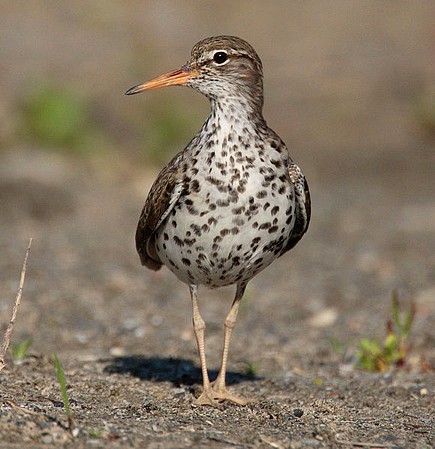
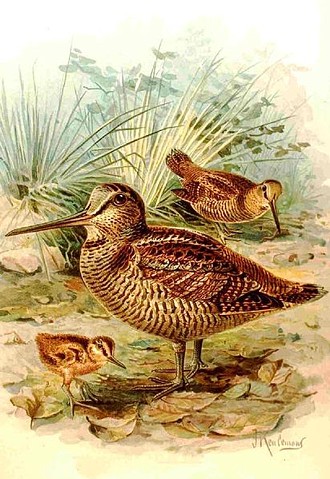
Scolopax rusticola
Gli Scolopacidi (Scopolacidae) sono una famiglia di uccelli prevalentemente acquatici (tranne rare eccezioni tra cui la beccaccia). Hanno zampe piuttosto lunghe, a volte vistosamente lunghe, ali appuntite, facilmente riconoscibili in volo, becchi lunghi e sottili. I piumaggi sono vari, e cambiano nel corso dell'anno, perciò per un'accurata identificazione di specie affini (ad esempio Tringa ochropus e Tringa glareola) occorre una valutazione dei disegni alari nonché delle barrature, degli specchi alari e dei disegni del groppone e della coda.
La maggior parte degli scolopacidi sono uccelli gregari, tranne che durante il periodo di riproduzione. Fa eccezione la beccaccia (Scolopax rusticola), che è un uccello solitario. Di solito nidificano sul terreno, a volte alcuni si riuniscono in grossi stuoli lungo la riva del mare.
In Europa la famiglia degli scolopacidi è rappresentata dai generi Calidris (piovanelli e piccoli piro-piro), Limicola, Tryngites, Philomachus, Lymnocryptes, Gallinago, Limnodromus, Scolopax, Limosa (pittime), Numenius (chiurli), Bartramia, Tringa (piro piro, totani e pettegole), Xenus, Actitis, Arenaria e Phalaropus (falaropi).
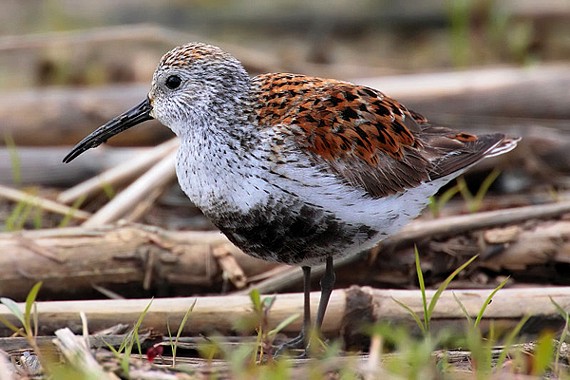
Calidris alpina
The Scolopacidae are a large family of waders (known as shorebirds in North America). Many of the smaller species are often called "sandpipers", especially members of genera Calidris, Tringa and Actitis. Other well-known groups include curlews and snipes. The majority of species eat small invertebrates picked out of the mud or soil. Different lengths of bills enable different species to feed in the same habitat, particularly on the coast, without direct competition for food.
Waders have long bodies and legs, and narrow wings. Most species have a narrow bill, but otherwise the form and length are quite variable. The bills are sensitive, allowing the birds to feel the mud and sand as they probe for food. Waders range in size from the Least Sandpiper, at around 11 centimetres in length, to the Eastern Curlew, at 66 centimetres in length. They generally have dull plumage, with cryptic brown, grey, or streaked patterns, although some display brighter colours during the breeding season. Most species nest in open areas, and defend their territories with aerial displays. The nest itself is a simple scrape in the ground, in which the bird typically lays three or four eggs. The young of most species are precocial.
This large family is often further subdivided into groups of similar birds. These groups do not necessarily consist of a single genus, but as presented here they do form distinct monophyletic evolutionary lineages. The early fossil record is very bad for a group that was probably present at the non-avian dinosaur's extinction. "Totanus" teruelensis Late Miocene of Los Mansuetos (Spain) is sometimes considered a scolopacid - maybe a shank - but may well be a larid; little is known of it. Paractitis has been named from the Early Oligocene of Sasketchewan (Canada). Most living genera would seem to have evolved throughout the Oligocene to Miocene with the waders perhaps a bit later; see the genus accounts for the fossil record. In addition there are some indeterminable remains that might belong to extant genera or their extinct relatives:
Piro
piro macchiato
Actitis macularia
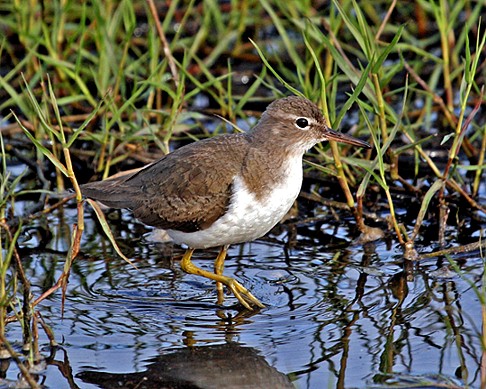
Il piro piro macchiato (Actitis macularia, Linnaeus 1766) è un uccello della famiglia degli Scolopacidae. Questo piro-piro vive in tutto il Nord e Sud America e nei Caraibi. È di passo nell'Europa centro-occidentale e settentrionale, Italia compresa, in Groenlandia, Islanda, Turchia, Marocco, su alcune isole dell'Atlantico centro-settentrionale e su Hawaii e Isole Marshall.
Spotted Sandpiper
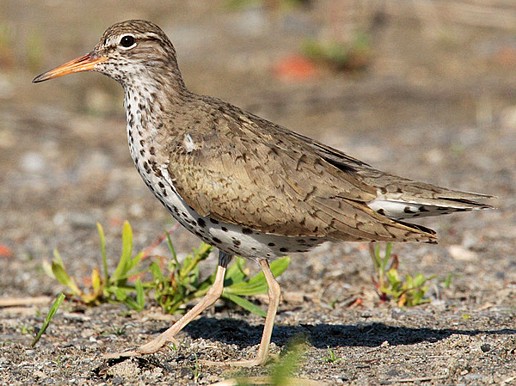
The Spotted Sandpiper (Actitis macularia) is a small shorebird, 18-20 cm long. Together with its sister species, the Common Sandpiper (A. hypoleucos) they make up the genus Actitis. They replace each other geographically; stray birds may settle down with breeders of the other species and hybridize. Their breeding habitat is near fresh water across most of Canada and the United States. They migrate to the southern United States and South America, and are very rare vagrants to western Europe. These are not gregarious birds and are seldom seen in flocks.
Adults have short yellowish legs and an orange bill with a dark tip. The body is brown on top and white underneath with black spots. Non-breeding birds do not have the spotted underparts, and are very similar to the Common Sandpiper of Eurasia; the main difference is the more washed-out wing pattern visible in flight and the normally light yellow legs and feet of the Spotted Sandpiper. The Acititis species have a distinctive stiff-winged flight low over the water.
Spotted Sandpipers nest on the ground. Females may mate with more than one male, leaving incubation to them. These birds forage on ground or water, picking up food by sight. They may also catch insects in flight. They eat insects, crustaceans and other invertebrates. As they forage, they can be recognized by their constant nodding and teetering.
Piro
piro piccolo
Actitis hypoleucos
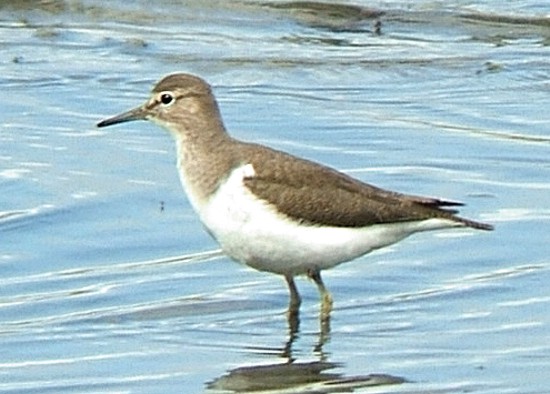
Il Piro piro piccolo (Actitis hypoleucos, Linnaeus 1758), è un uccello della famiglia degli Scolopacidae. Questo piccolo e panciuto uccello presenta un colore beige sul dorso fino sul petto, mentre il ventre è bianco latte, Le zampe sono lunghe circa trenta centimetri, poco più del becco. Il Piro piro piccolo è visibile in tutti i continenti, in Italia nidifica ovunque ci siano corsi d'acqua, tranne che in Sardegna e Sicilia. Sono riconoscibili le movenze di questo piccolo uccello dei greti e delle paludi, che come gli altri Piropiro, solitamente quando cammina muove la coda in alto e in basso ripetutamente. Nidifica in primavera inoltrata.
Common
Sandpiper
Actitis hypoleucos
The Common Sandpiper, Actitis hypoleucos, is a small Palearctic wader. This bird and its American sister species, the Spotted Sandpiper (A. macularia), make up the genus Actitis. They are parapatric and replace each other geographically; stray birds of either species may settle down with breeders of the other and hybridize. Hybridization has also been reported between the Common Sandpiper and the Green Sandpiper, a basal species of the closely related shank genus Tringa.
The adult is 18-20 cm long, with a 32-35 cm wingspan. It has greyish brown upperparts, white underparts, short dark-yellowish legs and feet, and a bill with a pale base and dark tip. In winter plumage, they are duller and have more conspicuous barring on the wings, though this is still only visible at close range. Juveniles are more heavily barred above and have buff edges to the wing feathers. This species is very similar to the slightly larger Spotted Sandpiper (A. macularia) in non-breeding plumage. But its darker legs and feet and the crisper wing pattern (visible in flight) tend to give it away, and of course they are only rarely found in the same location.
Beccaccino
Gallinago gallinago
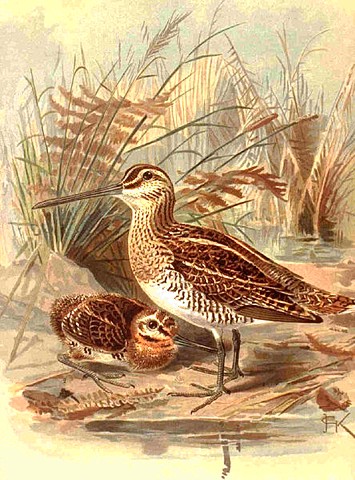
Il Beccaccino (Gallinago gallinago Linnaeus, 1758) è un uccello della famiglia Scolopacidae. Ha un becco lungo e sottile, raggiunge in media una lunghezza di 28 cm e un peso di 250 g. con una apertura alare di 49 cm. Ha un piumaggio variegato con tinte brune, rossicce e crema. Il capo è compresso lateralmente, gli occhi molto spostati indietro. Zampe lunghe e verdastre. Coda con poco bianco ai lati. Praticamente tranne che in Oceania è visibile in tutto il mondo, in Italia ci sono rari casi di nidificazione in ambienti palustri, durante la migrazione e lo svernamento gli habitat sono diversi, tranne che nei boschi si adatta dovunque, anche se predilige paludi, prati umidi, praterie e risaie.
Volo di levata a zig zag. Sfugge al pericolo acquattandosi sul terreno e mimetizzandosi perfettamente con la vegetazione e con il suolo. Durante le parate nuziali emette un U-U-U-U, mentre quando è in volo si possono udire degli gnec-gnec. Si ciba di molluschi, crostacei, vermi, insetti e vegetali. Nidifica tra l'erba e i giunchi, a volte tra l'erica. Vola in piccoli stormi. La specie ha un ampio areale geografico di distribuzione, stimato in oltre 10.000.000 km², con una popolazione mondiale stimata di 5.400.000 - 7.500.000 esemplari. In base ai criteri della IUCN Red List è considerata a basso rischio (LC). Beccaccino è anche il nome di un popolare gioco di carte.
Common
Snipe or Fantail Snipe
Gallinago gallinago
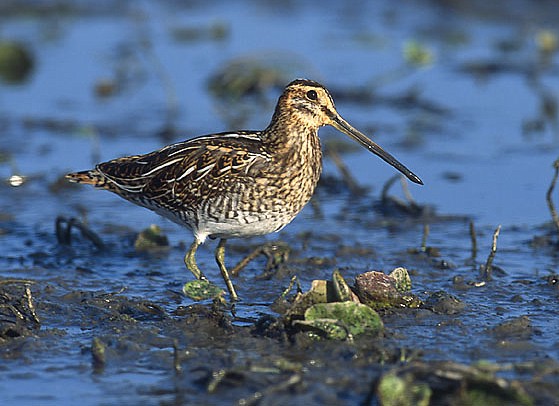
The Common Snipe or Fantail Snipe (Gallinago gallinago) is a small, stocky shorebird. The breeding habitat is marshes, bogs, tundra and wet meadows in Iceland, the Faroes, northern Europe and Russia. Common Snipe nest in a well-hidden location on the ground. European birds winter in southern Europe and Africa, and Asian migrants move to tropical southern Asia.
Adults are 23-28 cm in length with a 39-45 cm wingspan. They have short greenish-grey legs and a very long straight dark bill. The body is mottled brown on top and pale underneath. They have a dark stripe through the eye, with light stripes above and below it. The wings are pointed. These birds forage in soft mud, probing or picking up food by sight. They mainly eat insects and earthworms, also plant material. The male performs "winnowing" display during courtship, flying high in circles and then taking shallow dives to produce a distinctive sound - which has given the bird its Finnish name taivaanvuohi, "sky goat", because the sound is similar to the baaing of a goat.
This species closely resembles the Wilson's Snipe, G. delicata, of North America, which was until recently considered to be a subspecies G. g. delicata of Common Snipe. The latter differs from the North American species in having a wider white edge to the wings, and seven pairs of tail feathers instead of eight. There are two other races of Common Snipe; G. g. faeroeensis in Iceland, the Faroes, Shetland and Orkney, and G. g. gallinago in the rest of the Old World. The latter is a species to which the Agreement on the Conservation of African-Eurasian Migratory Waterbirds (AEWA) applies.
This well camouflaged bird is usually shy and conceals itself close to ground vegetation and flushes only when approached closely. They fly off in a series of aerial zig-zags to confuse predators. Snipe hunters, therefore, needed to be very skilled to hunt these birds and they came to be called snipers - a term later adopted by the military.